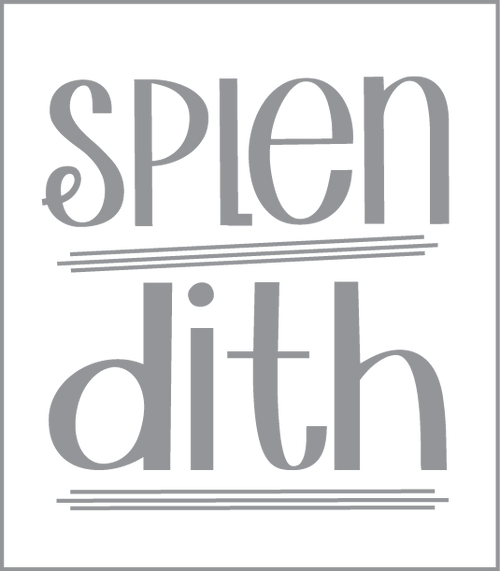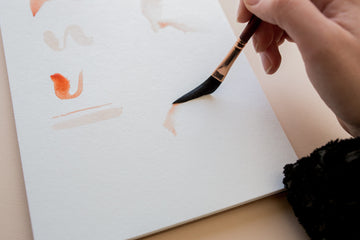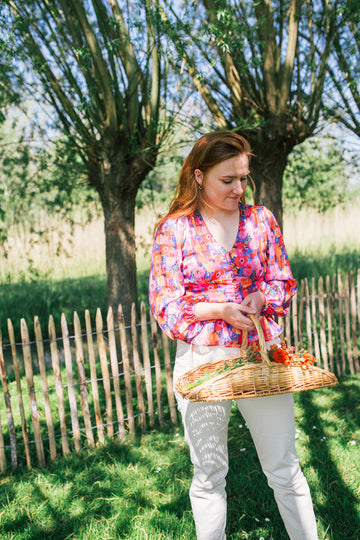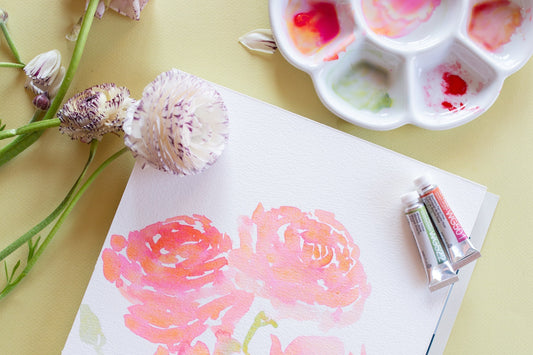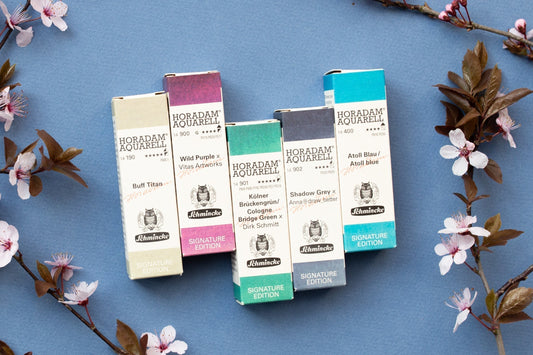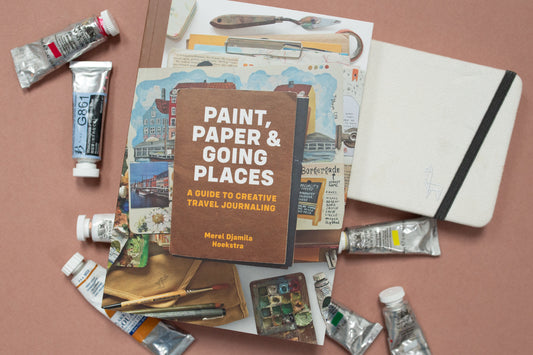Wat zijn nu goede penselen? Ik krijg vaak de vraag welke penselen geschikt zijn voor welk materiaal en wat nu eigenlijk het verschil is tussen penselen. Tijd dus om daar eens een goede en uitgebreide blog voor te schrijven. Ga er maar voor zitten, want dit wordt een uitgebreide blog. Voor een beknopte opsomming: bekijk dan even de productteksten van de Princeton penselen. Hierin lees je alles over de verschillende haren en vormen van de penselen uit de shop.
En dan nu de inhoudsopgave voor deze blog:
- Hoe is een penseel gemaakt?
- Wat voor penselen bestaan er?
- Voor welk materiaal gebruik je welk penseel?
- Hoe zit het met de verschillende vormen penselen?
- Waarop moet je letten in de aanschaf van een penseel?
- Princeton penselen
- Hoe maak je je penselen schoon?
- FAQ
Let’s go!

Hoe is een penseel gemaakt?
Voordat ik je alle losse onderdelen van een penseel ga uitleggen, leek het me wel zo handig om eerst bij de basis te beginnen. Op die manier weet je zo ook waarover ik spreek als je ineens jargon hoort. Op de illustratie kan je makkelijk zien hoe alles heet.
Een penseel bestaat dus uit een steel, een bus en de kwast (de haren). Je zou misschien denken dat de haren eerst in de bus worden geklemd, en dat ze daarna in een ronde vorm worden geknipt? Het gaat dus andersom. De haren worden eerst in de goede vorm gelegd en daarna aan de onderkant recht afgeknipt of passend gemaakt voor de bus. Daarna worden ze in de bus geklemd en die wordt op de steel gezet. Zo worden de hoogwaardige kwaliteit penselen gemaakt.
Het ‘leggen van de haren’ is een vak op zich, dit is een ambacht wat in een gebied in Duitsland erg veel wordt uitgevoerd. De materialen die daarvoor worden gebruikt lopen heel erg uiteen. De steel wordt meestal van hout gemaakt en heel soms van kunststof. De lengte van de steel wordt op een praktische manier bepaald. Aquarel penselen worden meestal gebruikt op klein werk. Om dicht op het werk te kunnen zitten, is het handig als je de steel niet te lang is. Als je groter werkt, bijvoorbeeld op een canvas, dan is het juist fijn als je een langere steel hebt om mee te werken, omdat je verder van het werk zit. Het grootste verschil bij penselen merk je in de haren, dat bepaalt voor het grootste gedeelte voor welk materiaal je een penseel kunt gebruiken.
Voor welk materiaal gebruik je welk penseel?
Je kan de penselen in verschillende categorieën indelen, ik hou het bij twee. Aquarel penselen zijn erg specifiek, terwijl de Mixed media penselen voor meer verschillende materialen gebruikt kunnen worden.
Aquarel penselen
Aquarel penseel
Een aquarel penseel is, misschien voor de hand liggend, geschikt voor aquarelverf. De haren van deze penselen zijn meestal geschikt om veel water/verf vast te houden en een goede punt te behouden. De haren van een penseel moeten een goede vorm behouden en flexibel uit kunnen waaieren, waarbij het water gecontroleerd uit het penseel vloeit.
Het is dus belangrijk dat de haren dan niet te soft worden en dat je een goede vorm houdt. Je wil niet dat je penseel als een mop over je papier heen waaiert. Het behouden van de controle is belangrijk bij een aquarel penseel.
Er zijn veel verschillende variaties in de flexibiliteit van penselen. Dat is het beste uit te leggen aan de hand van natuurlijke haren. Bij synthetische penselen wordt er meestal gerefereerd aan de natuurlijke haren voor hun eigenschappen. De meest gebruikte haren voor Aquarel penselen zijn:
Kolinsky sable
Dit zijn de duurste penselen die er beschikbaar zijn. De haren komen van de marter die leeft in Siberië. Voor de penselen wordt alleen de staart van een marter gebruikt. Deze penselen staan erom bekend dat ze een betrouwbare en fijne punt houden.
De synthetische vervanger voor deze penselen zijn de Princeton Heritage 4050 penselen.
Red sable
Deze haren zijn afkomstig van wezels. De haren zijn veerkrachtig en nemen heel veel water op. Dit is het iets voordeligere alternatief voor de Kolinsky penselen.
Eekhoornhaar
Eekhoornhaar is de zachtste soort haar die voor penselen wordt gebruikt. De haren zijn dun en heel fijn, kunnen ontzettend veel water opnemen door de structuur. De haren zijn wel een stuk minder elastisch, waardoor de punt minder dezelfde vorm behoudt. Omdat de haren zo zacht zijn, moet je het penseel met extra liefde behandelen. Zo moet je nooit te hard tegen de bus aandrukken, omdat de haren dan snel afbreken.
De synthetische vervanger voor eekhoornhaar is de Neptune reeks. Het extra voordeel van de synthetische vervanger is dat de haren wel dezelfde structuur hebben als eekhoornhaar, maar dat ze een stuk minder snel afbreken.
Is een aquarel penseel ook voor gouache?
Het is verwarrend of je een aquarel penseel met gouache kan gebruiken. Een aquarel penseel is niet geschikt bij het gebruik van zware soorten verf. Gouache is een waterverf, maar werkt anders dan een aquarelverf. Met gouache gebruik je meestal veel meer pigmenten, en die zijn zwaarder en stroever dan aquarelverf. Verdun je zelf gouache vaak nog met water? Dan kan je soms wel aquarel penselen gebruiken voor gouache.
Mixed Media penselen
Mixed media penselen: hieronder valt Acryl, Olie en waterverf. Voor andere soorten media dan aquarelverf worden veel verschillende soorten haren gebruikt. Denk bijvoorbeeld aan varkens- of runderharen. Deze soorten haren zijn een stuk stugger en zijn daarom geschikter voor stevige soorten verf.
Synthetische vervangers voor mixed media penselen is de Select range (student kwaliteit) en de Velvet touch reeks (Artist range)
Waarop moet je letten in de aanschaf van een penseel?
Het is onmogelijk om aan het uiterlijk van een penseel te zien, of het een goede kwaliteit penseel is. Helaas merk je dat vaak pas als je een penseel aan het gebruiken bent, je moet het dus echt uitproberen of je het penseel zelf ook fijn vindt werken. Het zal erg kostbaar worden om allerlei soorten penselen te testen. Daarom een twee belangrijke tips die je helpen bij de aanschaf van een penseel.
Kies voor kwaliteit over kwantiteit
Penselen kunnen een prijzige investering voor je zijn. Je bent sneller geneigd om voor het pack met meerdere penselen te gaan, dan voor één goed penseel. Waar je misschien bij de Flying Tiger een multipack koopt voor €5,- betaal je hetzelfde voor één hoogwaardige kwaliteit penseel. Met die multipack kan je vaak nét niet wat je wil met je penseel en daarnaast verliezen ze ook snel hun haren. Kies daarom liever voor een goed penseel, die je vervolgens voor alles kunt gebruiken en daadwerkelijk doet wat je wil. Je wil de controle over je penseel kunnen hebben, toch?
Synthetische of dierlijke haren?
Ik verkoop alleen synthetische penselen. Door moderne technieken zijn er zulke goede synthetische haren beschikbaar, dat ik daar liever gebruik van maak dan dierlijke haren.
In synthetische haren de goede eigenschappen van echte haren kunnen nabootsten. Zo hebben de haren dezelfde structuur als de echte haren, maar zijn ze verbeterd en breken bijvoorbeeld niet snel. Verder hebben synthetische penselen minder onderhoud nodig en kunnen ze beter tegen chemische reiniging, mocht je acryl verf gebruiken, dan kan dat erg handig zijn.
Voor acryl verf kan je sowieso het beste synthetische penselen gebruiken. Door de ingrediënten van de verf kunnen de natuurlijke haren worden aangetast. Bij synthetische haren heb je daar geen last van, mits je ze goed schoon houdt natuurlijk!

Hoe maak je een penseel goed schoon?
Als je een goed penseel hebt gekocht, wil je natuurlijk dat die lang mee gaat. Daarom is het heel belangrijk om je penseel goed schoon te houden. Daarmee verleng je de levensduur van je penselen aanzienlijk.
- Veeg eerst de resten verf van de huls en de kwast af
- Spoel dan je penseel af in het water: Aquarel, gouache en Acryl verf zijn oplosbaar in water. Andere materialen zoals olieverf spoel je af in terpentine of terpentijn (dit is geurloos)
- Druk dan nooit te hard op de punt van je penseel. Als je met de huls tegen de rand duwt, kunnen de haren op de rand van de huls afbreken.
- Gebruik dan handzeep en was de haren van het penseel voorzichtig met zeep totdat hij helemaal schoon is. Met synthetische haren zou je zelfs afwasmiddel kunnen gebruiken omdat synthetische haren niet uitdrogen.
- Spoel de zeep helemaal uit en sla het water uit de haren
- Vorm vervolgens de punt van het penseel weer in de juiste vorm
- Leg de penselen vervolgens neer om te drogen, zodra ze droog zijn zet je ze met de haren omhoog in bijvoorbeeld een beker.
What not to do
Laat een penseel nooit op de punt in het water staan. Daarmee verpest je de punt van een penseel, want die wordt dan krom.
Zet je penseel nooit met de haren omhoog weg terwijl de haren nog nat zijn. Dat zorgt ervoor dat de bus van je penseel nat blijft van binnen. Na verloop van tijd kunnen de haren dan loslaten.
Over de Princeton penselen
Princeton maakt alleen penselen en is al meer dan 30 jaar bezig met het ontwikkelen van de beste synthetische penselen. Daardoor hebben ze de nieuwste technologieën in de penselen verwerkt. In de shop verkoop ik vier verschillende ranges van Princeton. Elke range is geschikt voor een soort verf, en heeft zo de bepaalde eigenschappen. Het ene penseel houdt goed water vast met een reden, terwijl het andere penseel stevige haren heeft met een reden. Het is daarom belangrijk om een penseel te hebben dat past bij het materiaal dat je gebruikt. Bij deze nog een korte opsomming:
Toepassingen

Heb je vraagjes? Let met know.
Liefs,
Judith
